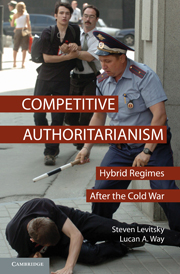Book contents
- Frontmatter
- Contents
- Acknowledgments
- Acronyms and Abbreviations
- Part I Introduction and Theory
- Part II High Linkage and Democratization: Eastern Europe and the Americas
- 3 Linkage, Leverage, and Democratization in Eastern Europe
- 4 Linkage, Leverage, and Democratization in the Americas
- Part III The Dynamics of Competitive Authoritarianism in Low-Linkage Regions: The Former Soviet Union, Africa, and Asia
- 8 Conclusion
- Appendix I Measuring Competitive Authoritarianism and Authoritarian Stability
- Appendix II Measuring Leverage
- Appendix III Measuring Linkage
- Appendix IV Measuring Organizational Power
- References
- Index
3 - Linkage, Leverage, and Democratization in Eastern Europe
Published online by Cambridge University Press: 05 June 2012
- Frontmatter
- Contents
- Acknowledgments
- Acronyms and Abbreviations
- Part I Introduction and Theory
- Part II High Linkage and Democratization: Eastern Europe and the Americas
- 3 Linkage, Leverage, and Democratization in Eastern Europe
- 4 Linkage, Leverage, and Democratization in the Americas
- Part III The Dynamics of Competitive Authoritarianism in Low-Linkage Regions: The Former Soviet Union, Africa, and Asia
- 8 Conclusion
- Appendix I Measuring Competitive Authoritarianism and Authoritarian Stability
- Appendix II Measuring Leverage
- Appendix III Measuring Linkage
- Appendix IV Measuring Organizational Power
- References
- Index
Summary
This chapter examines the trajectory of the six competitive authoritarian regimes that emerged in post-communist Eastern Europe: Albania, Croatia, Macedonia, Romania, Serbia, and Slovakia. Conditions for democratization in Eastern Europe were relatively unfavorable. Not only were some countries (e.g., Albania, Macedonia, and Romania) underdeveloped, but even in the more advanced countries (e.g., Croatia and Slovakia), decades of Leninist rule created obstacles to democratization that arguably exceeded those in most Latin American/Caribbean cases. Communist regimes were far more repressive and closed, banning virtually all forms of independent political expression, which resulted in weak civil societies in the 1990s. Moreover, legacies of central planning made it easier for post-communist autocrats and their allies to secure (formal or informal) control over key economic assets, thereby limiting opposition access to resources. Finally, every country except Albania experienced severe ethnic tension, and Croatia and Serbia suffered ethnic civil war.
Despite these obstacles, five of six Eastern European cases (Croatia, Macedonia, Romania, Serbia, and Slovakia) democratized during the post–Cold War period; the sixth case, Albania, very nearly democratized. This outcome, we argue, was rooted in a combination of linkage and leverage. Although the imposition of Soviet control after 1945 closed off ties to Western Europe throughout most of the region, the collapse of communism brought a dramatic expansion of linkage – in the form of rapidly expanding trade with the West; large-scale migration; and an invasion of Western media, NGOs, international organizations (IOs), and party organizations.
- Type
- Chapter
- Information
- Competitive AuthoritarianismHybrid Regimes after the Cold War, pp. 87 - 129Publisher: Cambridge University PressPrint publication year: 2010



